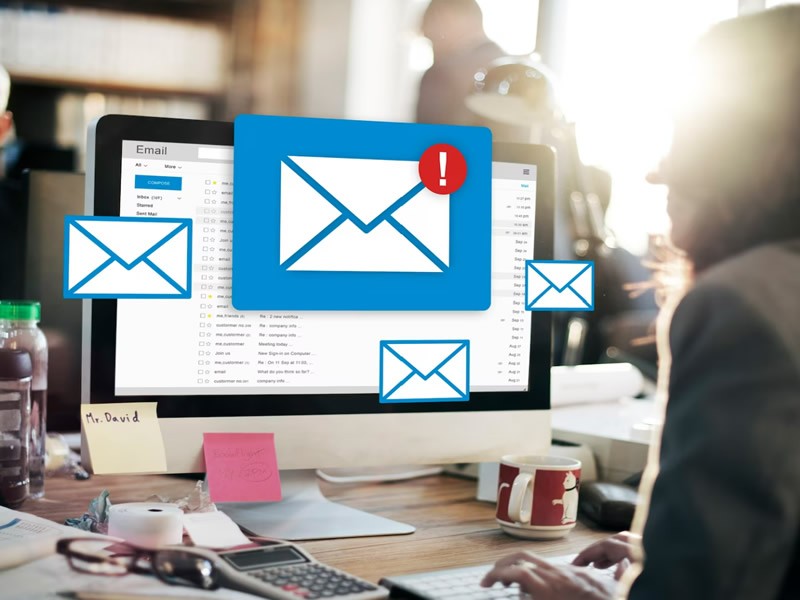Insight Blog
Agility’s perspectives on transforming the employee's experience throughout remote transformation using connected enterprise tools.
12 minutes reading time
(2392 words)
Top 10 Ideas to Reduce Email Overload
Learn to reduce email overload with 10 proven strategies, AI integration, organization, and efficient time management for a stress-free inbox.
People looking for ways to reduce email overload are on the rise, particularly with the increasing adoption of remote work by companies worldwide. Many requests go unaddressed as individuals grapple with the constant influx of new messages.
The issue of email overload is widespread in contemporary times. The constant influx of messages makes it challenging to stay on top of them and distinguish the important ones from the less crucial ones. Frequently checking your email throughout the day can disrupt your workflow and detract from valuable time that could be better allocated to more significant tasks.
Many individuals often feel compelled to reply to every email they receive, regardless of its significance or pertinence. Handling substantial volumes of email can be both time-consuming and exasperating.
Balancing work and personal life can become quite demanding when grappling with email overload.
Fortunately, there are effective ways to tackle this challenge.
This guide delves into email overload management, drawing insights from research to present ten best practices for handling emails at work. These strategies aim to reduce excessive email communication, enabling individuals to better cope with the deluge of messages they encounter daily.
Key Takeaways
- Additionally, using an email finder tool can help you manage and organize your contacts more efficiently, further reducing email overload.
- Utilize AI integration for smarter email responses and efficient communication.
- Set aside dedicated email management time to avoid constant distractions.
- Centralize communication and reduce emails by leveraging intranet collaboration tools.
- Maintain work-life balance by avoiding pre and post-work email checks.
What is Email Overload?
Email overload is the experience of stress and unease stemming from an overflowing inbox of unanswered emails.
While email overload isn't a recent development, concerns about excessive email communication date back to 2011 when researchers cautioned against the deluge of non-essential messages cluttering our inboxes.
Dealing with an inundated inbox can elicit strong negative emotions, as evidenced by research. A study discovered that email overload led to heightened levels of burnout and reduced work engagement, impacting individuals beyond their working hours.
As emails accumulate, it becomes challenging to distinguish between urgent and non-urgent messages, blurring the line between what's crucial and what can be deferred or disregarded.
How to spot the signs of email overload
The most glaring indicator of grappling with email overload emerges when your inbox contains hundreds of unanswered emails. As we've discussed, this situation can exert both psychological and even physical tolls on us.
In a New York Times article, Cal Newport asserts that email is a source of unhappiness. Newport contends that unanswered emails generate a persistent "background anxiety" that clings to us regardless of our location or circumstances.
In severe instances, the repercussions of email overload can manifest as typical symptoms of workplace stress, which include:
If you find yourself experiencing stress or if each email compounds your misery, here are some strategies to help you manage email overload.
In a New York Times article, Cal Newport asserts that email is a source of unhappiness. Newport contends that unanswered emails generate a persistent "background anxiety" that clings to us regardless of our location or circumstances.
In severe instances, the repercussions of email overload can manifest as typical symptoms of workplace stress, which include:
- 1. Fluctuating moods
- 2. Withdrawn behavior
- 3. Diminished motivation, commitment, and self-assurance
- 4. Heightened emotional reactions, such as increased tearfulness, sensitivity, or aggression
If you find yourself experiencing stress or if each email compounds your misery, here are some strategies to help you manage email overload.
How to Manage Email Overload?
Here is how to manage email overload in your workplace:
Follow us and access great exclusive content everyday: Follow us on Google News
1. Uncluttered Inboxes
To maintain light and uncluttered inboxes, employees should steer clear of subscribing to promotional materials, newsletters, and non-work-related subscriptions using their work email. Unsolicited promotional content can inundate your inbox without consent.
Taking a moment to unsubscribe from such emails can save you from a deluge of future unwanted messages and streamline your inbox.
Occasionally, it may be necessary to block a sender who repeatedly inundates your inbox irresponsibly. Inactive work-related emails should be archived and removed from the inbox. Lastly, ongoing email conversations should prioritize clarity and brevity to keep the inbox efficient.
Typically, professionals maintain over 200 emails in their inbox and receive an additional 120 new ones daily; however, they tend to respond to only a quarter of them.
Here are a few things to start with:
- Regular Sorting: Regularly sort and categorize emails into folders or labels to keep your inbox organized.
- Prioritize: Prioritize important emails and address them promptly, relegating less urgent ones to a separate folder.
- Unsubscribe: Routinely unsubscribe from newsletters and mailing lists you no longer find useful or relevant.
- Archive or Delete: Archive or delete emails you've already addressed to prevent unnecessary clutter in your inbox.
- Set Filters: Utilize email filters to automatically categorize and sort incoming emails, streamlining your inbox management.
2. Organization and Filters
Email marketing boasts an average of more than hundred. While this spells good news for businesses, it often translates to an inundated inbox for employees.
To separate crucial work emails from the deluge of promotional messages, it's crucial for individuals to establish inbox labels and filters. The organization of one's inbox often boils down to personal preference. Prioritizing company emails or activating notifications for high-priority messages, the choice is yours.
Regardless, a systematic approach is essential. A well-organized inbox can mean the difference between staying abreast of vital updates and resorting to email bankruptcy.
Try the following it might help with filtiing emails:
- Critical vs. Non-Critical: Distinguish between critical and non-critical emails. Prioritize those that require immediate attention or are time-sensitive.
- Use Email Flags: Utilize email flags or labels to mark important emails, making them easily identifiable in your inbox.
- Create Filters: Set up email filters to automatically categorize emails based on sender, subject, or keywords, helping you focus on relevant messages.
- Regularly Review: Schedule regular times during the day to review and respond to emails, avoiding constant interruptions to your workflow.
- Delegate When Possible: If an email involves tasks or questions that can be delegated to colleagues, do so to distribute the workload and ensure efficient handling.
You may also like: Best Apps for Employees: UPDATED 2022 – A Complete Guide
3. Collaboration Tools for Email Overload Reduction
In the quest to combat email overload, integrating a collaboration tool can be a game-changer. Such tools streamline email tracking and keep employees informed about updates, a particularly valuable feature when a single email account serves personal and professional purposes.
Collaboration platforms can transcend emails by establishing a centralized hub for communication and corporate data. Moreover, these tools can seamlessly sync with an employee's calendar, offering automated reminders for impending events.
This fosters better organization and communication, ultimately benefiting both the company and its workforce.
- AgilityPortal: AgilityPortal is a team communication platform that allows teams to collaborate in real-time through channels and direct messaging. By using AgilityPortal for internal discussions and quick internal announcement updates, you can reduce the need for lengthy email exchanges.
- Microsoft Teams: Microsoft Teams integrates with Microsoft Outlook and provides a platform for chat, video conferencing, file sharing, and project management. It's an effective way to keep team communication and collaboration separate from your email inbox.
- Trello: Trello is a visual project management tool that helps teams organize tasks, projects, and workflows. By using Trello boards, you can centralize project-related discussions and updates, minimizing the back-and-forth emails.
- Asana: Asana is a task and project management tool that allows teams to plan, organize, and track work. It offers features for assigning tasks, setting deadlines, and communicating within tasks, reducing the need for email communication on project details.
- Basecamp: Basecamp is a project management and team collaboration platform that includes to-do lists, document sharing, and message boards. By using Basecamp for project-specific discussions, you can keep your email inbox focused on important external communications.
These collaboration tools help streamline communication and reduce email overload by providing dedicated spaces for team discussions and project management, keeping email for external and high-priority communications.
4. Established Response Schedule for Effective Inbox Management
Allocating dedicated minutes daily for inbox management can significantly alleviate email overload.
Even during vacations, investing a mere 10 minutes to review the office inbox keeps employees informed about vital developments. This practice ensures acknowledgment or visibility of critical communications.
The choice of when to schedule email management should align with individual schedules, but consistency is key – aim for daily dedication to this task.
Here are five key points for establishing a response schedule to effectively manage your inbox:
- Set Regular Time Blocks: Dedicate specific time blocks in your daily schedule for checking and responding to emails. This creates structure and ensures you don't constantly interrupt other tasks.
- Prioritize Urgent Emails: Start each email session by addressing urgent or time-sensitive messages. This prevents critical matters from being overlooked.
- Categorize and Batch Process: Group similar emails together and process them in batches. For instance, handle all meeting requests, newsletters, or administrative tasks in one go to streamline your workflow.
- Use Templates and Quick Responses: Create email templates or use quick response features for commonly asked questions or routine communications, saving time on repetitive tasks.
- Notify Others of Your Schedule: Communicate your response schedule to colleagues or clients if necessary. This manages expectations and reduces the pressure to respond immediately to every email.
By adhering to an established response schedule, you can manage your inbox more effectively, reduce stress, and allocate your time and attention to other important tasks.
Free ebook: How To Get Your Intranet Off The Ground
5. Efficiency with Pre-designed Email Templates
For many routine official emails, a standardized response often suffices, typically requiring a straightforward acknowledgment.
Creating a set of templates tailored to common email scenarios can yield long-term time savings and contribute to mitigating email overload. Templates streamline the email response process, rendering it more straightforward and efficient.
Additionally, these preplanned templates help guarantee that emails encompass all essential information, sparing employees the inconvenience of revisiting details or re-sending emails due to omitted information.
6. Efficient Email Management with Scheduled Check-Ins
Rather than continuously monitoring your inbox, establish dedicated time slots throughout the day for concentrated email management. This approach aids in maintaining focus and mitigating the interruptions that frequent inbox checks can trigger.
Scheduled email check-ins provide an opportunity to concentrate on essential messages and avoid succumbing to the distractions posed by continuous notifications. By batching email checks at specific times, you can more effectively discern which emails demand immediate attention.
Initiating this practice involves allocating designated periods for email review, such as morning, post-lunch, and end-of-day sessions. Implementing a time limit for each email session is also advisable, ensuring adherence to efficient email management habits.
7. Leveraging Intranet Features to Tackle Email Overload
Intranet platforms offer valuable features that can significantly alleviate email overload. These tools enable organizations to centralize information, fostering efficient internal communication.
Features like discussion forums, document sharing, and project management tools promote collaboration without relying on email.
Employee engagement surveys and feedback mechanisms can also be integrated into intranet systems, streamlining communication and reducing the need for excessive emails. By harnessing these intranet capabilities, organizations can enhance productivity while minimizing email overload.
8. Opt-Out of Unwanted Emails and Subscriptions
For individuals grappling with an inundated inbox, opting out of irrelevant email subscriptions is a practical solution. Over time, we accumulate numerous newsletters, marketing materials, and promotional emails, contributing to inbox clutter.
Unsubscribing from these sources can substantially diminish the volume of emails, simplifying the process of locating and addressing important messages. This proactive step streamlines your inbox, ensuring that essential emails are easier to identify and manage amidst the reduced clutter.
9. Use AI for Efficient Email Handling
Efficiency in email management can be achieved by harnessing AI capabilities. The integration of OpenAI into your intranet empowers you to automate tasks intelligently.
OpenAI can suggest contextual quick responses to emails, reducing response time and streamlining email handling. Furthermore, it aids in composing emails effectively, enhancing clarity and efficiency in communication.
Additionally, it facilitates seamless international collaboration by providing translation services. Embracing AI through intranet integration optimizes email management, allowing you to work smarter and more productively.
10. Efficient Email Management Through Breaks and Limits
Constantly engaging with emails can be draining and time-intensive. To maintain your well-being and productivity, incorporating breaks into your day is essential. Establish time limits for daily email activities to prevent burnout.
Avoid checking emails before or after work to maintain a clear boundary between professional and personal life, reducing stress associated with work-related emails. By strategically taking breaks and enforcing time restrictions on email handling, you can alleviate overwhelm, reduce stress, and boost productivity. Finding your optimal balance and adhering to it enhances email management efficiency.
Wrapping up
In the age of remote work, email overload has become a pressing issue, inundating individuals with constant messages. This guide has explored ten valuable strategies to reduce email overload effectively.
From decluttering your inbox and utilizing filters to harnessing the power of intranet features and AI integration, these practices empower individuals to regain control over their email communications.
By adopting these techniques, you can reduce stress, enhance productivity, and navigate your inbox with greater ease, ensuring that essential messages don't get lost in the email deluge.
Frequently Asked Questions
What is email overload and why is it a concern?
Email overload refers to the overwhelming volume of emails in one's inbox, leading to stress and difficulty in managing them effectively. It's a concern because it can result in burnout, reduced work engagement, and hinder productivity. Distinguishing vital emails from less important ones becomes challenging, impacting both personal and professional life.
How can I efficiently manage my email subscriptions?
Efficiently managing email subscriptions involves unsubscribing from newsletters and promotional emails you no longer read or need. Regularly review your subscriptions and opt out of those that clutter your inbox. This reduces unnecessary emails, making it easier to locate and address important ones.
How does AI integration help streamline email handling?
AI integration, such as OpenAI in intranet, streamlines email handling by suggesting contextual quick responses, reducing response time. It also aids in composing emails efficiently, improving communication clarity. Additionally, it offers translation services, promoting international collaboration. Embracing AI optimizes email management, allowing for smarter and more productive work.
Categories
Blog
(2576)
Business Management
(315)
Employee Engagement
(204)
Digital Transformation
(171)
Intranets
(119)
Growth
(116)
Remote Work
(61)
Sales
(48)
Collaboration
(37)
Culture
(29)
Project management
(29)
Customer Experience
(26)
Knowledge Management
(21)
Leadership
(20)
Comparisons
(5)
Ready to learn more? 👍
One platform to optimize, manage and track all of your teams. Your new digital workplace is a click away. 🚀
Free for 14 days, no credit card required.














